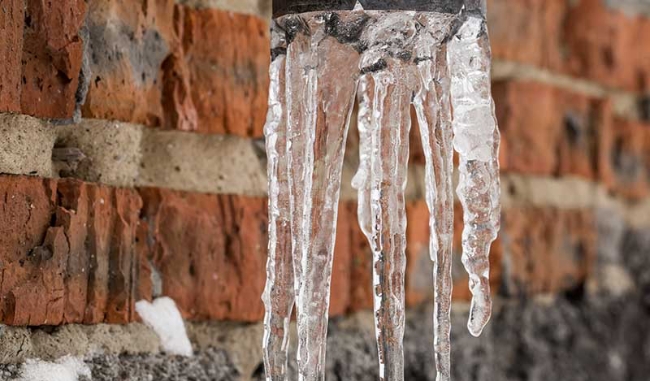Protecting Pipes from Cold Weather: Top Tips
Protecting Pipes from Cold Weather: Top Tips
Blog Article
Everyone may have their personal opinion with regards to Preventing and dealing with frozen pipes.

Winter can damage your pipes, specifically by freezing pipelines. Below's just how to avoid it from happening and what to do if it does.
Introduction
As temperature levels decline, the threat of icy pipes increases, potentially bring about expensive repair work and water damages. Understanding how to prevent icy pipes is vital for homeowners in cold climates.
Avoidance Tips
Insulating prone pipelines
Cover pipes in insulation sleeves or utilize heat tape to safeguard them from freezing temperature levels. Concentrate on pipelines in unheated or external areas of the home.
Home heating techniques
Keep interior rooms effectively warmed, particularly areas with pipes. Open up cupboard doors to allow warm air to flow around pipelines under sinks.
Just how to identify icy pipes
Look for lowered water flow from taps, uncommon smells or noises from pipelines, and visible frost on exposed pipes.
Long-Term Solutions
Architectural modifications
Take into consideration rerouting pipes far from exterior wall surfaces or unheated locations. Include added insulation to attics, cellars, and crawl spaces.
Upgrading insulation
Buy top notch insulation for pipelines, attics, and walls. Appropriate insulation helps keep consistent temperatures and lowers the risk of icy pipes.
Securing Outside Pipes
Yard hose pipes and exterior faucets
Detach and drain pipes yard hose pipes prior to winter season. Set up frost-proof spigots or cover outdoor faucets with protected caps.
Comprehending Frozen Pipelines
What triggers pipes to freeze?
Pipelines freeze when revealed to temperatures below 32 ° F (0 ° C) for expanded periods. As water inside the pipelines freezes, it broadens, putting pressure on the pipeline walls and possibly creating them to rupture.
Risks and damages
Icy pipelines can cause supply of water interruptions, residential property damages, and expensive repairs. Ruptured pipelines can flooding homes and create comprehensive architectural damages.
Indications of Frozen Piping
Recognizing frozen pipelines early can avoid them from breaking.
What to Do If Your Pipelines Freeze
Immediate actions to take
If you presume icy pipes, maintain taps open to alleviate pressure as the ice thaws. Use a hairdryer or towels soaked in hot water to thaw pipelines gradually.
Final thought
Avoiding frozen pipelines calls for aggressive measures and quick feedbacks. By comprehending the causes, indicators, and preventive measures, homeowners can secure their pipes during cold weather.
5 Ways to Prevent Frozen Pipes
Drain Outdoor Faucets and Disconnect Hoses
First, close the shut-off valve that controls the flow of water in the pipe to your outdoor faucet. Then, head outside to disconnect and drain your hose and open the outdoor faucet to allow the water to completely drain out of the line. Turn off the faucet when done. Finally, head back to the shut-off valve and drain the remaining water inside the pipe into a bucket or container. Additionally, if you have a home irrigation system, you should consider hiring an expert to clear the system of water each year.
Insulate Pipes
One of the best and most cost-effective methods for preventing frozen water pipes is to wrap your pipes with insulation. This is especially important for areas in your home that aren’t exposed to heat, such as an attic. We suggest using foam sleeves, which can typically be found at your local hardware store.
Keep Heat Running at 65
Your pipes are located inside your walls, and the temperature there is much colder than the rest of the house. To prevent your pipes from freezing, The Insurance Information Institute suggests that you keep your home heated to at least 65 degrees, even when traveling. You may want to invest in smart devices that can keep an eye on the temperature in your home while you’re away.
Leave Water Dripping
Moving water — even a small trickle — can prevent ice from forming inside your pipes. When freezing temps are imminent, start a drip of water from all faucets that serve exposed pipes. Leaving a few faucets running will also help relieve pressure inside the pipes and help prevent a rupture if the water inside freezes.
Open Cupboard Doors
Warm your kitchen and bathroom pipes by opening cupboards and vanities. You should also leave your interior doors ajar to help warm air circulate evenly throughout your home.

As a reader on How to Prevent Your Pipes From Freezing, I figured sharing that segment was a smart idea. Are you aware of someone else who is intrigued by Helpful Tips to Prevent Frozen Pipes this Winter? Why not promote it. I cherish reading our article about Prevent Frozen Pipes .
Visit Our Website Report this page